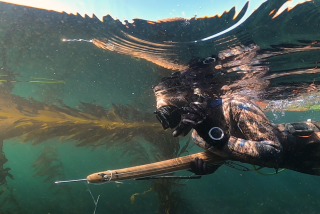The Lingcod Doesn’t Make a Pretty Trophy, but It’s Large, Tasty and Plentiful These Days, Making the Distinctive Fish . . . : Tops on the Bottom
- Share via
OXNARD — The lingcod’s teeth, as well as the gillrakers, are extremely sharp and can cause serious injury to the fingers of careless anglers. Unless you are wearing heavy gloves, NEVER put your fingers into the mouth or gill chamber of a lingcod. --Department of Fish and Game
Ron Mueller’s lingcod came over the rail nearly four feet long, with a mouth almost as big as its head and a set of jaws that could double as a bear trap.
It didn’t take a fisheries biologist to figure out that this fish should be handled with care, as suggested by the DFG in its sportfish identification booklet.
But by looking at the lingcod, with its cavernous mouth and its bulging brown eyes, its mottled brown skin and a greenish tint on its otherwise white underbelly, you wouldn’t think it would be such a hit among Southland anglers.
Yet, when Mueller’s catch hit the deck, those aboard the Pacific Dawn were all smiles as they bounced their lures off the bottom hoping that they, too, would hook such a prize.
“This is the best thing going in Southern California right now,” said Mueller, 29, of Thousand Oaks. “There’s nothing else like it.”
True enough. The water is too cold for tuna. The time isn’t quite right for yellowtail and white seabass. It’s the dead of winter, and most of the action is on the bottom, whether it’s 50 feet or 350 feet.
And while anglers may be able to fill their sacks with a variety of bright-red rockfish that thrive at such depths, they would much rather latch onto a lingcod.
“I’m mostly a tuna man myself,” said Mike Burens, 33, who came from Lancaster to see what this lingcod madness was all about.
Burens, like the others who boarded the Pacific Dawn for its 1 a.m. run to the deep-water fishing grounds off Santa Rosa Island, had been reading the fish counts.
“We had 83 on one trip (early last month),” said John Shull, 36, owner-operator of the CISCO Sportfishing-based vessel. “Two-thirds of the boat had their (five-fish) limits. Guys were throwing back 20-pounders.”
Mueller took the largest lingcod on that trip, a 44 1/2-pounder that was nearly as big around as it was long.
“You could have put a football in its mouth,” Mueller said.
And chances are, it would have burst the pigskin.
The all-tackle world record lingcod is a 69-pounder caught off British Columbia in 1992. That one could have swallowed the pigskin.
Shull refers to the fish as “gators,” and with good reason.
Lingcod, actually a member of the greenling family, are caught from Alaska to Baja California, and have been taken from as deep as 2,700 feet.
They are extremely territorial and will attack anything that poses a threat or represents a meal.
On the day Shull’s customers bagged 83 lingcod, the fish couldn’t stay away from the heavy metal jigs used by Bob Neil, 39, a Pacific Dawn regular from Port Hueneme.
Neil caught 11, six of which were taken on one drift over one of the many high spots of 300 feet in an otherwise seemingly bottomless Pacific. And he lost 11 more.
“There was only one guy who didn’t catch any,” Neil said. “But he was sleeping over that last drift.”
Said Shull: “We had them hanging onto rockfish (hooked) on (multi-hooked) gangions, and they would let go and swim back down when we’d try to gaff them. We had some that would hold onto the lure for 300 feet and spit it out right before they got to the surface.”
And thus expectations were high among the 24 anglers who paid $60 each to board Shull’s boat shortly after midnight, wake up twice in the dark to try unsuccessfully to catch bait near Santa Cruz Island, then rise again at dawn to try for lingcod.
Armed with 10- to 16-ounce chrome and painted jigs that sell for $5 to $12 apiece, the groggy fishermen attached them to their Dacron line--necessary to fish such depths because it doesn’t stretch like monofilament--and sent them over and to the bottom.
Mueller, bouncing his hand-painted, zebra-colored jig off the bottom, reeling as the boat drifted over the peaks and ridges and letting line out to reach the bottom when it drifted over canyons and valleys, felt a tug within minutes. He set the hook and gave a few quick reels, enough to turn the head of the fish and keep it from the rocks.
Instead of pumping and reeling--the method used for most gamefish--Mueller merely tried to keep a tight line, reeling fast when the fish would swim toward the surface and holding tight when it would make a dash for the bottom.
His patience paid off when after several minutes he had the fish within range of a gaff. It was hauled on board, carried down the rail past envious onlookers, and stuffed in his sack.
Neil hooked up a bit later and after a few minutes had his lingcod at the surface. Others watched in disbelief as he instructed the crew to release the fish, whose flesh, green as it sometimes is while raw, cooks up a succulent, flaky white.
Neil claimed to be doing his part to protect the fishery, but the fact that he still had lingcod fillets in his freezer from previous trips might have had something to do with it.
Mueller and Neil took turns catching lingcod while most of the others settled for such listless--but equally delicious--rockfish as chilipepper, vermilion rockfish (commonly called red snapper or red rock cod) and bocaccio. None of the fishermen, regardless of experience, would escape with all tackle intact, decorating the rocky bottom with about $200 worth of shiny lures by day’s end.
But before the sun set, Burens, the tuna man, hooked into a lingcod that worked his arms for several minutes before coming to gaff and over the rail, measuring only about three feet but so full of eggs that it weighed 29 pounds and edged Mueller’s fish for the daily jackpot.
After several more drifts, Shull, realizing that it was a four-hour trip to the landing, said he would make two more before calling it a day.
Mueller had already caught six lingcod and Neil five, but both fished intently trying to get one bigger than Burens’.
The action increased, but the fish being brought over the rail were mostly small rockfish, many of them bocaccio, also called salmon grouper and the least-prized among the anglers because their flesh sometimes contains worms, which may cook out in the oven but do little for the appetite.
“I once saw a fillet crawling across the fillet board,” Mueller exclaimed as he bounced his jig along the bottom, “and I wasn’t even drinking, but that made me want a drink.”
Shull was happy because the sacks were being filled, which would satisfy his customers. And after one more drift, as the high spot disappeared from his meter and the bottom dropped steadily, he said it was time to reel in.
In all, 19 lingcod were landed, not as many as on previous trips but a good total nonetheless for a species generally caught only incidentally.
The rods were stored, the engines fired up, and a course was set for Oxnard. Soon the setting sun was turning the horizon red and gray whales spouted in the distance. Many of the passengers retired to their bunks, while others wandered about the stern deck, taking a last look at the day’s catch before the deckhands turned it into fillets.
Burens, the tuna man and lingcod king for a day, used both arms to lift his fish out of the gunny sack. Staring into its massive mouth, he smiled in awe and muttered to himself, “You can see why anything’s fair game with these suckers.”
More to Read
Sign up for Essential California
The most important California stories and recommendations in your inbox every morning.
You may occasionally receive promotional content from the Los Angeles Times.









